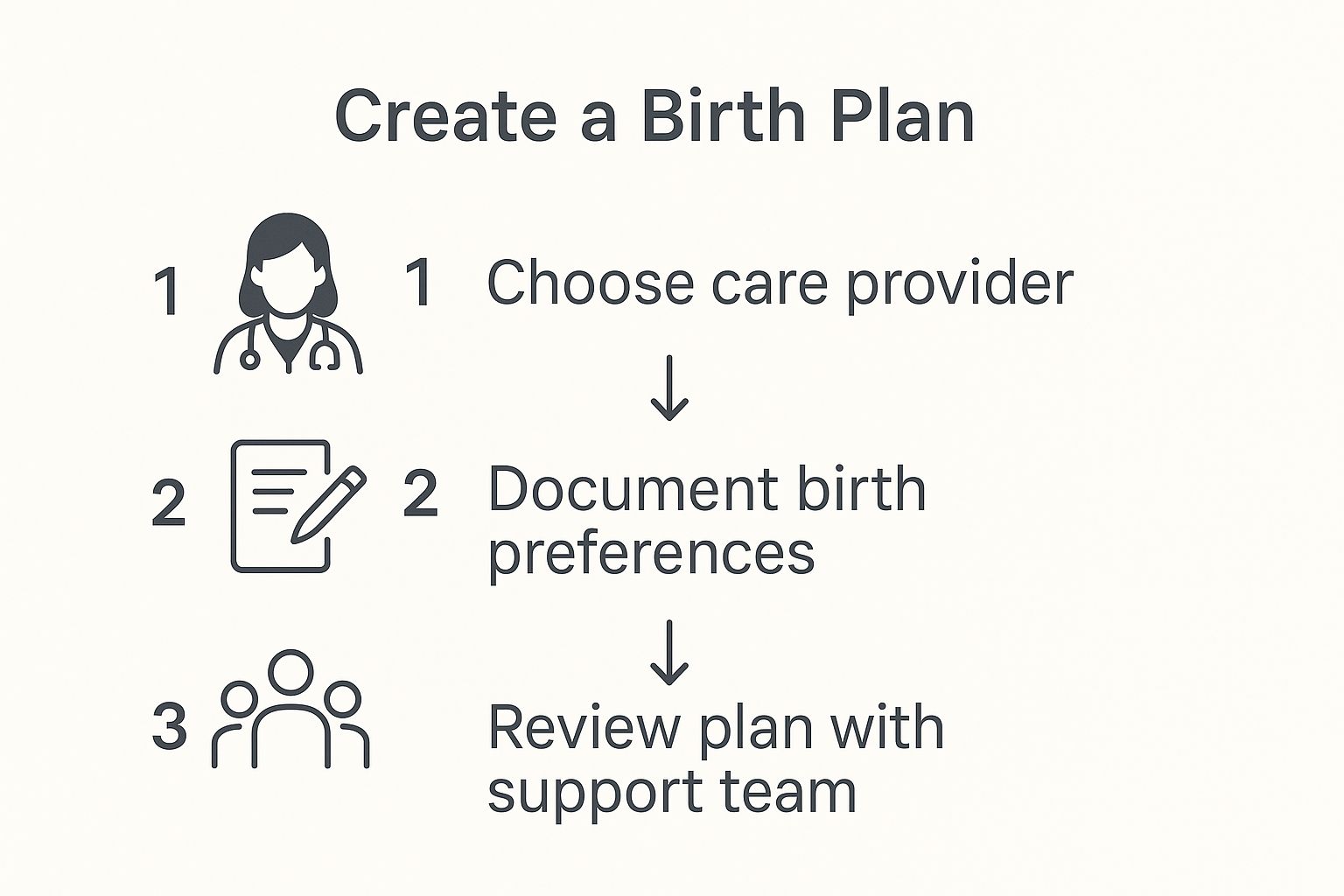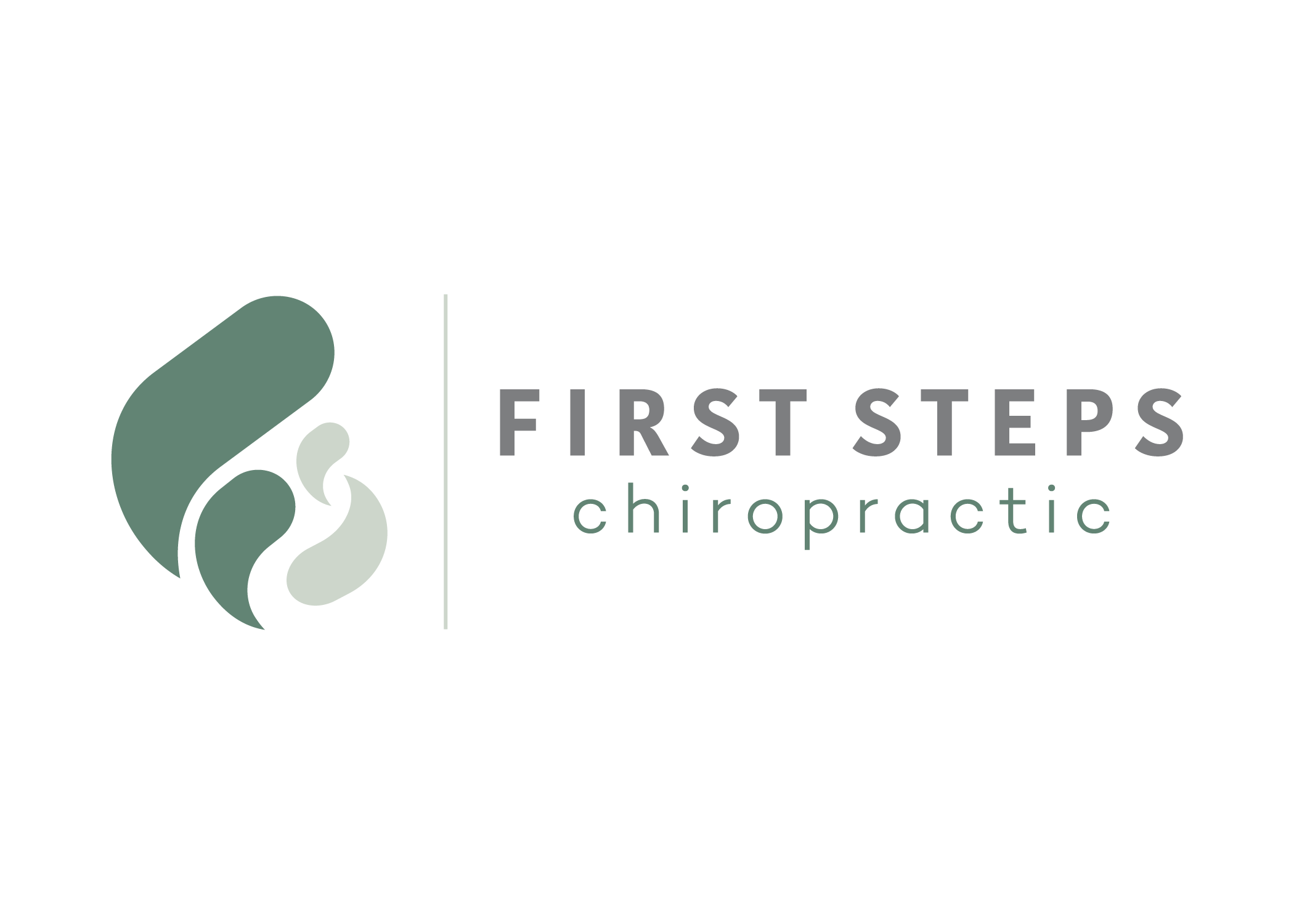Choosing to have a natural childbirth is a powerful decision. It's about more than just skipping an epidural; it's a deep commitment to understanding and trusting your body's incredible ability to bring your baby into the world. It’s a journey of preparation—mentally, physically, and logistically—to create an environment where you feel supported, confident, and in control.
What It Really Means to Prepare for Natural Childbirth
When you start preparing for a natural birth, you're actively choosing to partner with your body’s powerful, innate rhythms. This isn't about roughing it out. Instead, it's a modern, informed approach that allows labor to begin and progress on its own timeline, using a whole toolkit of non-medical techniques for comfort and progress.
The goal is to feel empowered and informed, no matter which direction your unique birth story takes. This kind of deep preparation really comes down to three key areas.
The Big Three: Physical, Mental, and Practical Prep
- Physical Conditioning: Think of labor as a marathon. You need to train for it! This means building strength and stamina through targeted exercises, fueling your body with optimal nutrition, and even seeking specialized care like chiropractic to encourage your baby into the best possible position for birth.
- Mental Fortitude: Labor is intense. Developing emotional resilience and practical pain-coping strategies is crucial. This is where you learn to navigate the intensity with a sense of calm and focus.
- Practical Planning: This is your logistics headquarters. It’s about mindfully choosing your support team, creating a flexible birth plan, and selecting a birth environment where you feel completely safe, heard, and respected.
A Modern Perspective on Natural Birth
So why is this preparation so important today? While most births worldwide are vaginal, the rate of Cesarean sections has been steadily climbing. In the United States, for instance, C-sections now account for 32.3% of all births—that's over 1,161,896 babies born via surgery compared to 2,431,500 born vaginally.
This trend really underscores the need for proactive preparation. Being educated and physically ready are major factors in promoting a spontaneous vaginal birth, which often leads to a quicker, smoother recovery for both you and your baby. If you're curious about the bigger picture, you can review more data about global reproductive health strategies to see these trends for yourself.
The goal isn’t to have a "perfect" birth, but an empowered one. True preparation gives you the tools to advocate for yourself, make informed decisions in the moment, and work collaboratively with your care team.
Thinking about how to prepare for natural childbirth shouldn't feel like a rigid, overwhelming checklist. It's much more about cultivating a deep sense of readiness from the inside out.
It's about learning to listen to your body’s cues and building a versatile toolkit of strategies—from specific breathing techniques to different laboring positions—that you can pull from whenever you need them.
This all-encompassing approach ensures you feel equipped for the beautiful challenges and immense joys ahead. By focusing on these key areas, you’re not just getting ready for a single day; you're laying the foundation for a positive start to parenthood.
Key Pillars of Natural Childbirth Preparation
Here’s a quick-glance table that breaks down the essential components of preparing for an empowered natural birth. Think of these as the foundational pillars that support your entire journey.
| Preparation Pillar | Primary Goal | Examples of Activities |
|---|---|---|
| Physical Conditioning | To build stamina, strength, and encourage optimal fetal positioning for a smoother labor. | Prenatal yoga, perineal massage, pelvic floor exercises, chiropractic adjustments, nutrient-dense diet. |
| Mental Fortitude | To develop emotional resilience and effective pain-coping strategies for navigating labor. | Childbirth education classes, practicing mindfulness, creating affirmations, breathing techniques. |
| Practical Planning | To create a supportive, safe, and well-organized environment for your birth experience. | Hiring a doula, writing a birth plan, packing your hospital bag, touring your birth location. |
Ultimately, preparing this way helps you create a supportive playbook for one of life’s most amazing events, setting the stage for a healthy, positive start for both you and your baby.
Building Your Physical Foundation for Labor

Think about preparing for a marathon. You wouldn't just show up on race day without months of dedicated training, would you? Giving birth is your body's own marathon, and building a strong, capable physical foundation is one of the most empowering things you can do.
This isn’t about pushing yourself through exhausting, high-intensity workouts. It’s about smart, intentional movement that works with your body. Proper preparation can boost your stamina, help you manage the intensity of labor, and even encourage your baby into a great position for birth.
Essential Movements for Labor Preparation
Getting familiar with certain movements throughout your pregnancy can make a world of difference when the time comes. These exercises focus on opening your pelvis and building stability—two things that are absolutely essential for a smoother birth.
Try adding these into your daily routine:
- Deep Squats: This is a classic for a reason. A deep squat, even with support from a chair or doorknob, helps open the pelvic outlet. This gives your baby more room to make their way down and out.
- Pelvic Tilts: A lifesaver for pregnancy back pain! You can do these standing, on your hands and knees, or even lying down. Just gently tuck your pelvis under and then release. It's a subtle move that strengthens crucial core muscles.
- Cat-Cow Stretches: Get on your hands and knees and flow between arching your back (cat) and dropping your belly (cow). This movement is fantastic for spinal flexibility and can help coax a baby from a posterior ("sunny-side up") position into a more optimal one.
Think of these not just as exercises, but as practice. The more comfortable you get in these positions now, the more instinctual they will feel during labor.
Mastering Your Pelvic Floor
When we talk about the pelvic floor during pregnancy, the conversation often goes straight to Kegels and strengthening. But that's only half the story. The ability to relax your pelvic floor is just as important—if not more so—for a natural birth.
Your pelvic floor has a big job to do: it needs to release and open to let your baby pass through. If those muscles are too tight and tense, they can act like a roadblock, potentially slowing things down.
Key Insight: A truly functional pelvic floor for birth is both strong and flexible. Learning to consciously relax these muscles is a skill you can practice. It’s like a "reverse Kegel"—a gentle bearing down and letting go.
This balanced approach gives your muscles the ability to support you during pregnancy and then open up effectively when it's go-time.
Fueling Your Body for Birth
That final trimester is the home stretch, and your body's nutritional needs are at an all-time high. You're not just growing a baby; you're stockpiling the energy reserves needed for the incredible work of labor.
Focus on a diet packed with:
- Complex Carbohydrates: Oats, sweet potatoes, and whole grains are your friends. They provide slow-release energy for lasting stamina.
- Lean Protein: Crucial for muscle function and repair. Think chicken, fish, beans, and lentils.
- Healthy Fats: Don't skip these! Avocados, nuts, and seeds are vital for hormone production and overall cellular health.
And please, stay hydrated. Dehydration is a fast track to muscle cramps and can even trigger Braxton Hicks contractions. Keep a water bottle handy and sip throughout the day, not just when you feel thirsty.
Specialized Support: Prenatal Chiropractic and Massage
Sometimes, your body needs a little extra help getting into alignment for birth. This is where specialized, hands-on care can be a complete game-changer.
Prenatal Chiropractic Care: A chiropractor with prenatal certification can be instrumental in ensuring your pelvis is properly aligned. A misaligned pelvis can make birth more challenging. The Webster Technique, specifically, is a chiropractic analysis and adjustment designed to reduce sacral subluxation and sacroiliac joint dysfunction. The goal is to improve the neuro-biomechanics of the pelvis, giving your baby the space to get into the best possible head-down position. For a deeper dive, you can explore our full guide on how to prepare for a natural birth and the role of professional support.
Prenatal Massage: This is more than just a relaxing treat. A skilled prenatal massage therapist can release deep tension in your hips, lower back, and shoulders—all the places that take on extra strain during pregnancy. Releasing that tension now helps your body stay more relaxed and less tense when labor begins.
By combining daily movement, targeted muscle work, smart nutrition, and specialized care, you are building an incredible physical foundation. This preparation empowers you to walk into your labor feeling strong, capable, and ready.
Cultivating Mental and Emotional Resilience for Birth

While getting your body physically ready for birth is important, the real marathon often happens between your ears. Preparing for a natural childbirth means building a mindset that is strong, flexible, and ready to meet intensity with calm confidence. This is where you shift from fearing the unknown to truly embracing your body's innate power.
The mind-body connection during labor is incredibly potent. When you feel fear, your body instinctively tenses up, which can dial up the pain. This creates a challenging feedback loop known as the fear-tension-pain cycle. Your most effective tool for breaking this cycle isn't physical—it's your mind.
Powerful Pain-Coping Strategies
The word "coping" is key here. It isn’t about eliminating sensation but about learning to work with it. These strategies are designed to keep you centered and in control, even when things feel overwhelming.
The trick is to start practicing these techniques long before your due date so they become second nature.
- Patterned Breathing: This is so much more than just "breathing through it." Techniques taught in methods like Lamaze or Bradley involve specific, rhythmic breathing patterns. For example, a slow, deep inhale through your nose for a count of four, followed by a long, gentle exhale through your mouth for a count of six, can instantly calm your nervous system.
- Guided Visualization: Don't underestimate the power of your imagination. Close your eyes and vividly picture your cervix opening like a flower, or imagine each contraction as a powerful wave you can ride to shore. The more detailed your mental picture, the more effective it becomes.
- Positive Affirmations: The words you repeat to yourself matter. Simple, powerful phrases can completely reframe your response to labor's intensity. Instead of letting "I can't do this" creep in, you actively replace it with "My body was made to do this" or "I am strong and capable."
Real-World Tip: Write your favorite affirmations on index cards. Have your partner or doula read them to you during labor. Hearing those powerful words from a supportive voice can be a game-changer when you're deep in the process.
The Power Of Education
Knowledge is the ultimate antidote to fear. When you understand what’s happening in your body during each stage of labor, the process becomes far less mysterious and intimidating. This is why a solid childbirth education is a cornerstone of preparing for natural birth.
Reputable programs like the Bradley Method (which heavily involves the birth partner) or Lamaze provide a full education on the physiology of birth. You learn what to expect, how to advocate for yourself, and what your options are every step of the way. This kind of knowledge transforms you from a passive patient into an active, informed participant in your own birth story. You can also explore the power of the Webster Technique for pregnancy to see how other specialized knowledge can contribute to a better birth experience.
Letting Go Of The "Perfect" Birth
Here’s a crucial piece of mental prep: embrace flexibility. It’s wonderful to have preferences and a vision for your birth. However, holding on too tightly to a single, "perfect" outcome can set you up for disappointment if your labor takes an unexpected turn.
Birth is a beautifully unpredictable dance between you and your baby. Sometimes, the plan needs to change for the safety and well-being of you both. True mental resilience isn't about forcing your birth to fit a script; it's about having the inner strength to navigate any twists with grace and confidence.
This mental and emotional preparation is a critical aspect of women's health around the globe. In regions with fewer medical resources, a woman's knowledge and resilience can be lifesaving. For instance, in 2013, sub-Saharan Africa and Southeast Asia accounted for about 690 of the 800 daily global deaths from childbirth-related causes. Improving outcomes in these areas involves not just better medical access but also empowering women with education on labor, delivery, and self-advocacy.
Your preparation—understanding your body, practicing coping strategies, and building a flexible mindset—is about creating the best possible conditions for a positive experience, no matter what that looks like on the day.
Assembling Your Birth Plan and Support Team

Once your body and mind are primed for labor, it's time to tackle the logistics. This is where you figure out who will be in your corner and how you’ll communicate your wishes on the big day. Think of it this way: a solid plan and a trusted support system are the scaffolding that holds up your entire birth experience, freeing you up to focus on the incredible work of labor.
This part of your preparation isn’t about creating a rigid, unbreakable script. It’s more like drawing a flexible roadmap. You're making informed choices now so you aren’t forced to make them under pressure later.
Choosing Your Birth Environment and Provider
Where you give birth and who guides you through it are two of the most significant decisions you'll make. The right environment can make all the difference in helping you feel safe and comfortable, which is absolutely essential for letting labor unfold naturally.
You generally have a few options, each with its own vibe:
- A Hospital: This is the most common choice and offers immediate access to a full spectrum of medical interventions if they become necessary. When looking at hospitals, ask about their C-section rates and if they offer amenities that support natural birth, like birthing tubs or wireless monitors.
- A Birthing Center: This is a fantastic middle ground. It offers a cozy, home-like setting but with trained medical staff (usually midwives) right there. These centers are specifically designed for low-intervention births.
- A Home Birth: For those who feel most at ease in their own space, a home birth provides the ultimate control over your environment. You’ll be attended by a certified professional midwife (CPM) or a certified nurse-midwife (CNM).
Your choice of provider—whether an OB-GYN or a midwife—is just as crucial. Take the time to interview them. You need to know if their philosophy aligns with yours. Don't be shy about asking direct questions, like what their C-section rates are and how much experience they have supporting unmedicated labor.
Crafting a Flexible Birth Preferences Document
Let's ditch the term "birth plan." It can come across as rigid and even demanding. I much prefer calling it your "birth preferences" or "birth wishes." This document is really a communication tool, designed to help your care team quickly understand what’s most important to you.
The trick is to keep it concise, positive, and flexible. One page is ideal. A busy nurse or doctor should be able to scan it in 60 seconds and get the gist.
Pro Tip: Frame your preferences with a collaborative spirit. I often suggest starting with a sentence like, "We are hoping for a natural, unmedicated birth and would be so grateful for your support in helping us achieve our goals. We also understand that plans may need to change to ensure the safety of both mom and baby."
This simple shift in tone sets you up as a team, not as adversaries. Your document should touch on your main preferences for labor, the delivery itself, and the immediate postpartum period.
Building Your Core Support System
Labor is not a solo sport. The people you invite into that space can dramatically influence your experience. A strong, prepared support team offers the physical comfort, emotional encouragement, and advocacy you’ll need.
Your team might include:
- Your Partner: A well-prepared partner is your first line of defense. They can offer counter-pressure during contractions, make sure you're staying hydrated, and advocate for your preferences when you're deep in "labor land" and focused inward.
- A Doula: A doula is a trained professional who provides continuous physical, emotional, and informational support. Research consistently shows that having a doula can lead to shorter labors and a reduced need for medical interventions. They don't replace your partner; they enhance the team.
- A Trusted Friend or Family Member: This person needs to be a calm, supportive presence who is 100% on board with your goals for a natural birth.
Once you have your team, communicate openly with them. Walk them through your birth preferences document. More importantly, explain the why behind your choices. The more they understand your vision, the better they can show up for you.
This logistical and emotional preparation is just as foundational as ensuring your body is physically ready for labor. On that note, many expecting parents find that chiropractic care helps create a more comfortable and functional birthing process. For more information, you can check out the top reasons pregnancy chiropractic is beneficial. By building a team that is educated, aligned with your vision, and ready to support you, you create a circle of trust that allows you to surrender to the incredible power of birth.
Navigating Each Stage of Labor Naturally
It helps so much to understand what’s happening during labor before it actually starts. Think of it like having a map for an incredible, life-changing journey. While every single birth story is unique, labor generally follows a predictable pattern. Knowing what to expect and having a toolkit of strategies for each phase will empower you to work with your body, stay focused, and feel in control.
The whole process is usually broken down into three main stages. The first stage is the longest and has three distinct phases of its own: early labor, active labor, and transition. Let's walk through them one by one so you know just what to do when the time comes.
The Gentle Beginning: Early Labor
This is often the longest part of labor, but thankfully, it's also the least intense. Contractions usually feel like mild menstrual cramps, they come and go irregularly, and they don't demand all of your attention just yet. They might be 15-20 minutes apart and last for about 30-60 seconds. For many moms, this phase can last for several hours or even a full day.
The two most important things you can do during early labor are rest and hydrate. Seriously. The real work hasn't started yet, so this is your chance to conserve your energy for the main event.
- Try to sleep or nap if contractions start at night. Don’t fight it!
- Eat light, easily digestible snacks to keep your energy stores up.
- Go for a gentle walk to help things progress, but don't wear yourself out.
- Distract yourself. Watch a movie, listen to music, or tackle some of those last-minute nesting projects.
This is the "marathon, not a sprint" part of the day. If you can, resist the urge to rush to your birthing location too soon. Laboring comfortably in your own space for as long as possible can help you avoid unnecessary interventions and stay relaxed.
Working with Intensity: Active Labor
You'll know you've hit active labor when the contractions become stronger, longer, and much more regular. They'll likely be about 3-5 minutes apart and last for a minute or even longer. This is when your full focus is required, and it's time to dig into that pain-coping toolkit you’ve been practicing.
Now is when you'll want to lean heavily on your support team. Your partner, doula, or family member can provide absolutely crucial physical and emotional support.
Comfort Measures for Active Labor:
- Change positions frequently. Don't just lie in bed! Try standing and swaying, leaning over a birth ball, or getting on your hands and knees.
- Use hydrotherapy. A warm shower or bath can offer remarkable relief from the intensity of contractions.
- Ask for counter-pressure. Having your partner press firmly on your lower back or hips during a contraction can feel incredible.
- Remember your breathing techniques. Use your patterned breathing to stay centered and get oxygen to your hard-working muscles.
Key Takeaway: Gravity is your best friend during active labor. Staying in upright, forward-leaning positions helps open your pelvis and uses the weight of the baby to encourage your cervix to dilate.
The Final Climb: Transition
Transition is the shortest but most intense phase of the first stage of labor. It’s the powerful bridge that takes you from about 8 centimeters to the full 10. Contractions are incredibly strong, very close together, and it’s normal to feel shaky, nauseous, or completely overwhelmed.
This is the point where many women have a moment of self-doubt, famously saying, "I can't do this anymore!" If you hear yourself saying that, take heart—it’s a classic sign that you are incredibly close to meeting your baby. Your support team's encouragement is paramount now. Their job is to remind you that you are doing it and that this intensity is productive and has a purpose.

Having a clear, well-communicated birth plan helps your support team advocate for you when you're fully focused on the work of labor.
The Second Stage: Pushing and Birth
Once your cervix is fully dilated, you'll move into the second stage: pushing your baby out into the world. For some, the urge to push is overwhelming and completely instinctual. For others, it’s a more subtle pressure. It’s so important to listen to your body and your care provider’s guidance.
This stage can last anywhere from a few powerful minutes to a few hours. Finding a pushing position that works for you is key. While lying on your back is what we see in movies, it’s often not the most effective position because it works against gravity. Squatting, side-lying, or using a birthing stool can open your pelvis more and make pushing more efficient.
The Third Stage: Delivering the Placenta
You did it! Your baby is here, resting on your chest. But there's one final, small step. After your baby is born, your uterus will continue to have mild contractions to deliver the placenta. This usually happens within 5 to 30 minutes after birth and is far less intense than what you just experienced.
This beautiful stage is also when initial bonding, skin-to-skin contact, and the first feeding often take place, wrapping up your incredible natural childbirth journey. Understanding these stages is a universal need for parents everywhere, yet access to this kind of education varies dramatically. For perspective, the worldwide birth rate is around 17.30 births per 1,000 people, but that number hides huge regional differences that impact how families can prepare. You can explore the data on global birth rate trends to see just how population dynamics shape childbirth resources across the world.
Common Questions About Natural Birth Preparation
Even with all the books, classes, and practice, it’s completely normal to have some questions still swirling in your mind as your due date gets closer. Thinking about how to prepare for a natural childbirth can definitely bring up some specific worries.
Let's walk through some of the most common concerns I hear from expecting moms. My hope is that we can tackle these head-on and leave you feeling even more confident and ready for your birth day.
How Will I Know When It’s Really Labor?
This is the big one, especially for first-time moms. It’s easy to get thrown off by Braxton Hicks contractions and wonder if this is it. Think of Braxton Hicks as your body’s dress rehearsal—they’re unpredictable, they don’t get stronger, and they usually fade away if you move around or drink some water.
Real labor is different. It finds a rhythm. True labor contractions will become:
- Stronger: You’ll feel a noticeable increase in their intensity.
- Longer: Each one will last a bit longer than the one before.
- Closer Together: The breaks in between will get shorter and shorter.
A great guideline for knowing when to head to your birth center or hospital is the 5-1-1 rule. This means your contractions are coming every 5 minutes, each one is lasting for 1 minute, and this pattern has been consistent for at least 1 hour.
What If the Pain Is Too Intense?
The fear of pain is completely valid, but you’ve been building a huge toolkit for this very moment. It helps to reframe what this pain is. It’s not like the pain of an injury; it’s productive and purposeful. It’s the sign that your body is working powerfully to bring your baby into the world.
Trust in all the techniques you’ve been practicing. Your patterned breathing, your visualizations, your partner’s touch—these are incredibly powerful anchors.
Remember this: transition, the most intense part of labor, is also the shortest. That moment when you feel like you can’t possibly go on is often a sign that you are so, so close to meeting your baby. Lean hard on your support team to remind you of your own strength.
Can I Still Have a Natural Birth If I’m Past My Due Date?
Yes, absolutely! It’s important to remember that due dates are just an estimate. In fact, only about 5% of babies are born on their actual due date. Going a week or even two past that date is very common and normal.
If your provider brings up the idea of induction, this is where all your preparation truly shines. It’s time for an open, informed conversation about your options. Ask about the benefits, the risks, and any alternatives to encourage labor to start on its own. Your birth plan and your own knowledge empower you to be a key player in this decision.
What if I Need an Intervention I Didn't Plan For?
A huge part of preparing for a natural birth is also preparing to be flexible. The real goal, above all else, is a healthy mom and a healthy baby. Sometimes, an unexpected medical turn means an intervention is the safest path to get there.
This is not a failure. All of your hard work—the physical conditioning, the mental and emotional prep—was not for nothing. It has given you the strength and clarity to handle whatever your birth journey throws at you, making decisions from a place of confidence, not fear. Your birth story is still yours, and every part of it is meaningful.
At First Steps Chiropractic, we are dedicated to helping expectant mothers feel their best throughout pregnancy and prepare their bodies for a smoother labor. Our specialized prenatal care, including the Webster Technique, focuses on optimal pelvic alignment to support a positive birth experience. Learn more about how we can support your journey.

